Sewage sludge: odour emissions assessment
This report is part of the research project undertaken by the James Hutton Institute on the impacts on human health and environment arising from the spreading of sewage sludge to land (CR/2016/23).
4. Methodology
4.1 Sampling
The measurement of odour emission rates was based on the collection of samples of odour in inert "plastic" sample bags from a ventilated hood placed over freshly exposed sludge cake. The objective of sampling material within the stockpile, rather than on the external surfaces was to sample cake which had not been 'weathered' by exposure to the atmosphere, as happens on the surface of stockpiles. The reasoning for sampling material within the stockpiles is that material within the body of the stockpiles represents the greatest mass of material exposed to the atmosphere during and after land application (spreading) which is when odour emissions are most critical.
When a suitable location was identified for sampling, the Scottish Water or Veolia contractor removed the surface layers of cake on the 'side' or 'end' of the stockpile with a loader or excavator bucket to provide a flat surface. A ventilated 'Lindvall' hood was then placed on the exposed surface of sludge cake in/on the stockpile and the hood ventilated with clean, odour free air provided by a battery powered fan and an activated carbon filter, as shown in Figure 1. The underside of the hood is equipped with a series of vanes to form seal on the cake and, most importantly, to direct the airflow back and forth across the cake to increase the flow path and to air speed at the cake surface (Figure 2).
Triplicate odour samples were collected from each cake sampled to help minimise the effects of measurement uncertainties in the odour measurement.
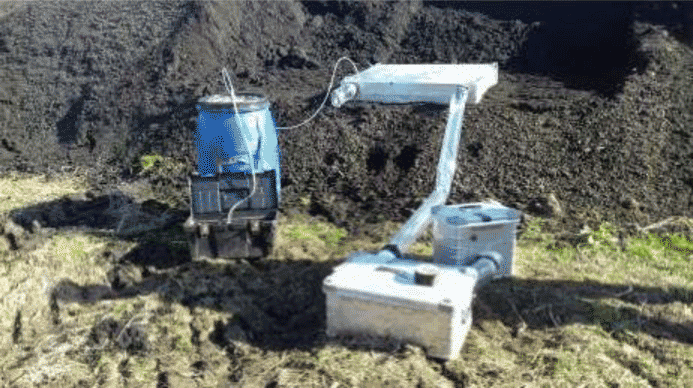
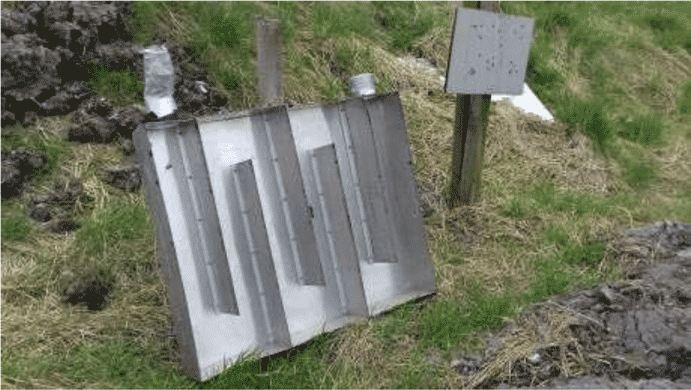
The Lindvall hood was ventilated with clean air by a battery powered, portable fan (in the smaller aluminium case in Figure 1) blowing air through a carbon filter (in the larger aluminium case).
Once the hood was settled on the sludge cake, odour free (filtered) air was blown into the hood through the clear polyethylene terephthalate (PET) ducting. This air then traversed back and forth across the surface of the sludge cake under the hood, 'collecting' odour, and was then exhausted through ducting from the other end of the labyrinth formed under the hood by the vanes. The odour (air) samples were collected from this air stream off the hood through an inert sampling tube to new PET ('Nalophane') sample bags.
The sampling hood is shown in use on the three different types of sludge cake in Figures 3, 4 and 5 below.
These air samples were then used to measure the emissions of odour from the area of sludge cake covered by the sampling hood, by multiplying the odour concentration of the odour samples by the rates of ventilation through the Lindvall hood.
The sample hood was ventilated for 5 minutes before the first of each set of three samples was collected and then the three odour samples were collected sequentially, with each sample collected over a period of four minutes. Airflow rates exiting the sampling hood were measured with a vane anemometer and records were made of sampling times together with ambient air temperature, hood exit air temperature and sludge cake temperatures measured 50mm below the cake surface with an electronic thermometer.
Indicative measurements were made of ammonia (NH3) concentrations in air exiting from the hood during collection of the second odour sample for each cake using Kitagawa SD105 NH3 gas indicator tubes using either single or multiple full (100ml) or half (50ml) pump strokes as required. Ammonia has a relatively high odour detection threshold and as consequence is normally of very little consequence in ambient odours. Ammonia is known to be evolved at quite high rates during and immediately after lime treatment of liquid sludge and sludge cakes, that is within the confines of the treatment processing plant and buildings at sewage/sludge treatment works.
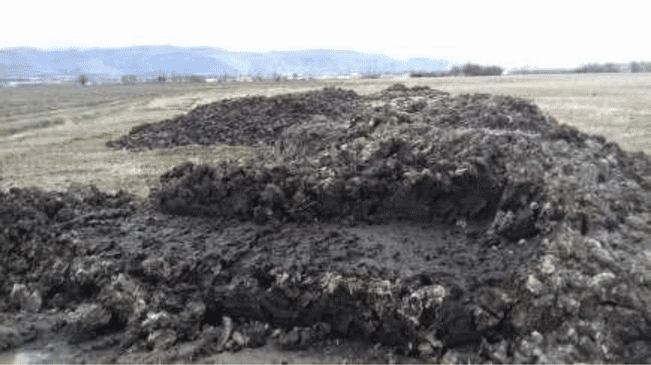
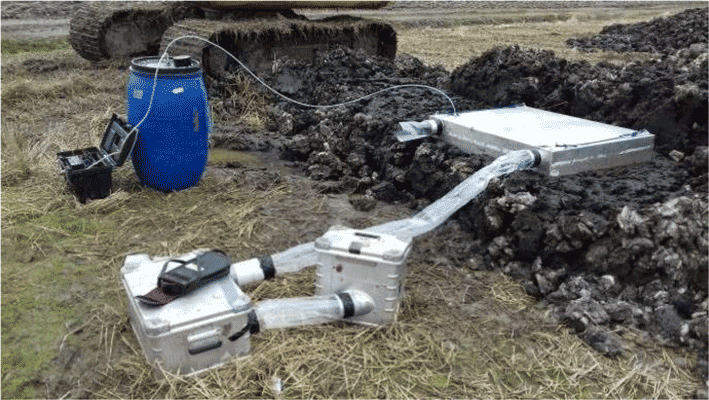
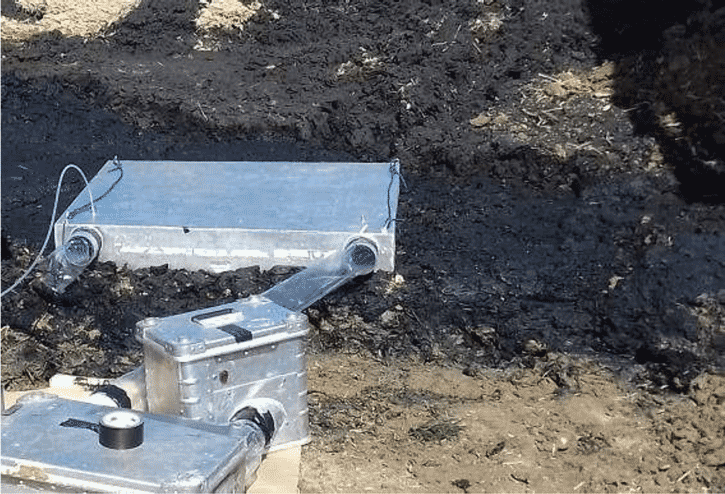
4.2 Odour Sample Analysis
The odour sample bags on site were transported to the UKAS accredited Silsoe Odours odour analysis laboratory and analysed within 30 hours of collection in accordance with the British/European Standard BS EN 13725. Odour concentrations were determined by presenting the samples to a panel of six human "sniffers" who sniffed the diluted sample at a range of dilution rates, starting at a high dilution ratio so that the panellists did not initially detect the odour and then sequentially decreasing the dilution ratios increasing until the odours were just detected. The presentations were carried out through a pair of sniffing horns, as shown in Figure 6, with the diluted sample randomly switched between the two sniffing horns for each different dilution presentation. The panellists selected which sniffing horn they thought was presenting the sample at each dilution rate and they also provided a response about the certainty of their decision, choosing from a 'guess', an 'inkling' or a 'certain' choice. The objective was to determine the number of dilutions of a sample which was required to just make the sample detectable to 50% of the panel of sniffers. This number (of dilutions) equates to an odour concentration in European odour units per cubic metre of air (ouE/m3).
The odour laboratory also measured hydrogen sulphide (H2S) concentrations in the sample bags using a
Jerome 631 H2S analyser. Jerome meters have some cross sensitivity to other compounds, so that the readings/results do not provide an absolute measurement of H2S, but they do give some indication of a) the extent to which there may have been septicity and anaerobic decay within the sludge cakes, and b) the propensity of the spread cake odours to have 'drain' or 'faecal' elements. The H2S measurements were indicative and not part of the Silsoe Odours UKAS accreditation.
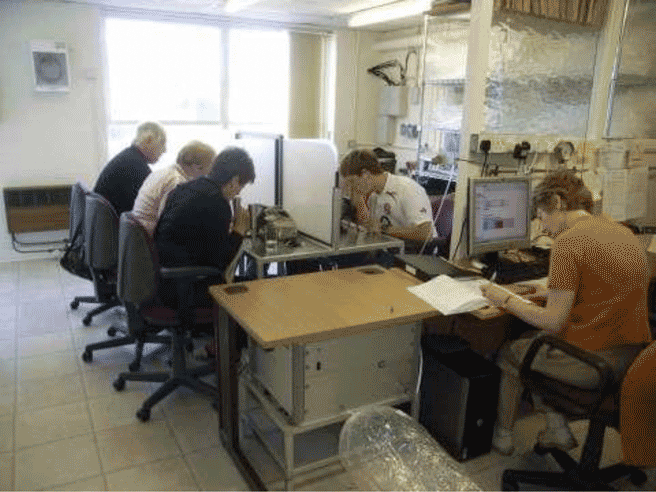
4.3 Odour Emission Rate Calculations
The odour concentrations results determined by the odour analysis were then multiplied up by the measured airflow rate at the outlet of the Lindvall sampling hood to determine an odour emission rate, calculated as European odour units per second (ouE/s). Geometric mean odour concentrations were calculated for each set of three samples. Geometric means are used by convention in presenting the results of olfactory measurements because the human response to odours is approximately logarithmic.
The emission rate for each set of measurements was divided by the area of sludge covered by the hood to provide an area specific odour emission rate, expressed as odour units per second per square metre of sludge cake surface (ouE/s/m2). These units allow direct comparisons to be made between specific odour emission rates for each of the different sludge cakes and cake 'ages'.
Similar calculations were also carried out for indicative area specific emissions of H2S and NH3.
Contact
Email: gary.gray@gov.scot
There is a problem
Thanks for your feedback